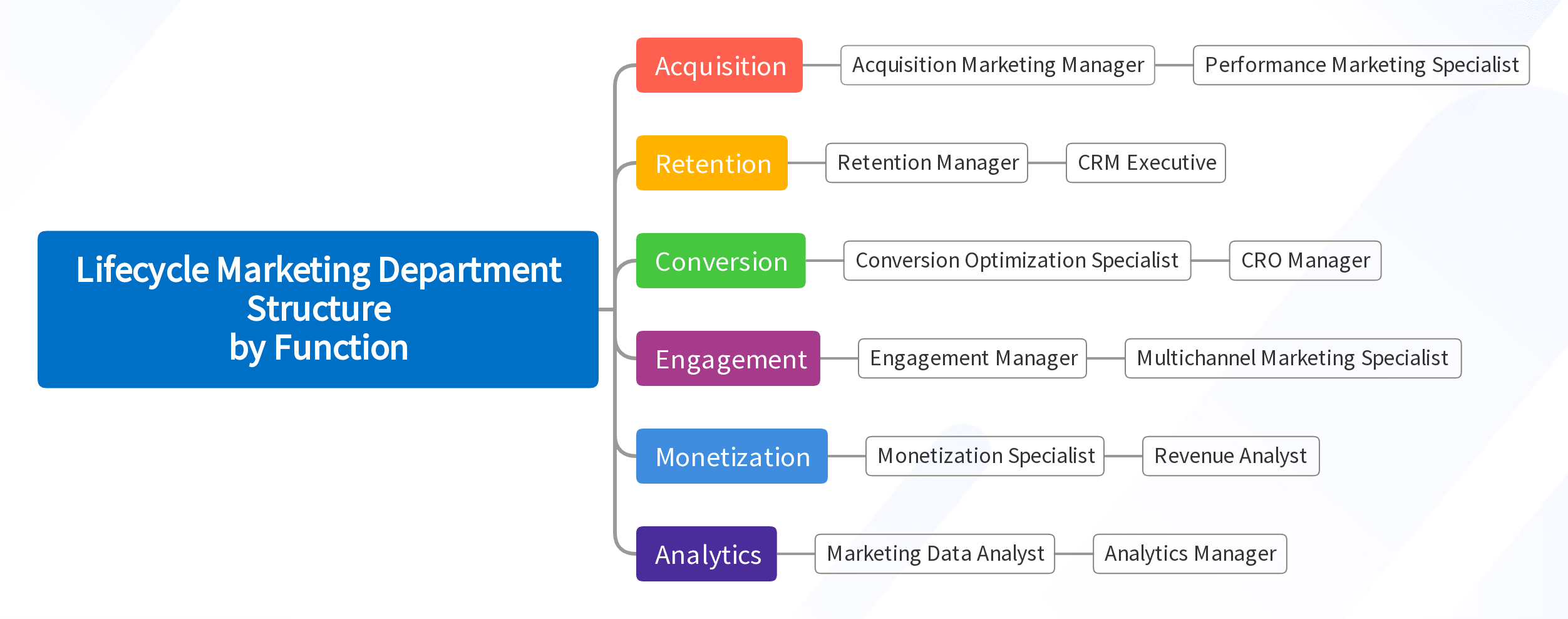

Navigating the dynamic business landscape requires a robust strategy. Lifecycle Marketing teams play a pivotal role in this context.
Their structure and organization can greatly enhance a company's success. Understanding this is vital for both budding entrepreneurs and seasoned professionals. I've been running my own successful marketing agency for years so I speak from experience.
But first, let's talk about the Lifecycle Marketing department structures you have to choose from.
Best for Growth Marketers
Best for Paid Ads & CMO's
Table of Contents
Structuring Lifecycle Marketing Department
There are two main types of department structures based on company size and resources.
- Lifecycle Marketing department structure by discipline
- Org Type: Traditional corporate departments
- Best For: Midsize/Enterprise companies
- Lifecycle Marketing department structure by function
- Org Type: Employees are grouped by activities and objectives
- Best For: Small to Medium Sized Business (SMB)
Let’s go in-depth to each one of them.
1. Lifecycle Marketing Department Structure by Discipline


Discipline-based structure involves building teams centered around various marketing disciplines. For example, SEO, Content, Market Research, and Product Strategy could each form separate teams within a department.
| Discipline | Key Skills | Potential Roles |
|---|---|---|
| Strategy | Market Research, Competitive Analysis, Trend Forecasting, Analytical Skills | Lifecycle Marketing Strategist, Senior Marketing Analyst |
| Content | Copywriting, SEO, Content Management, Storytelling | Content Marketing Manager, Copywriter |
| Design | Graphic Design, UX/UI Design, Branding, Adobe Creative Suite | Graphic Designer, Art Director |
| Email Marketing, CRM, Data Analysis, A/B Testing | Email Marketing Specialist, CRM Manager | |
| Social Media | Social Media Strategy, Content Creation, Community Engagement, Analytics | Social Media Manager, Community Manager |
| Data | Data Analysis, CRM, Segmentation, Predictive Modeling | Data Analyst, Customer Insights Analyst |
| SEO | Keyword Research, SEO Copywriting, Link Building, Analytics | SEO Specialist, SEO Manager |
| Events | Event Planning, Vendor Management, Promotional Marketing, Relationship Building | Events Coordinator, Event Marketing Manager |
2. Lifecycle Marketing Department Structure by Function


Another approach is structuring by function, where teams are formed based on the different functions they perform. For example, promotion, launches, and relationship management could all be separate teams.
| Function | Key Skills | Potential Roles |
|---|---|---|
| Acquisition | Customer Acquisition, Performance Marketing, ROI Analysis, A/B Testing | Acquisition Marketing Manager, Performance Marketing Specialist |
| Retention | Customer Retention, Relationship Management, CRM, Customer Analytics | Retention Manager, CRM Executive |
| Conversion | Conversion Rate Optimization, A/B Testing, User Experience, Analytics | Conversion Optimization Specialist, CRO Manager |
| Engagement | Content Strategy, Multichannel Marketing, CRM, Customer Engagement | Engagement Manager, Multichannel Marketing Specialist |
| Monetization | Pricing Strategy, Revenue Optimization, Cross-Selling and Up-Selling, Financial Analysis | Monetization Specialist, Revenue Analyst |
| Analytics | Data Analysis, Predictive Analytics, Data Visualization, Statistical Modeling | Marketing Data Analyst, Analytics Manager |
Lifecycle Marketing Team Size versus Business Scale
To achieve successful marketing outcomes, you need to align the team size with your business's scale – a strategic approach that helps optimize resources and drive targeted growth.
| Business Scale | Ideal Department Size | Explanation |
|---|---|---|
| Start-up | 1-3 | Limited resources and relatively fewer customers. |
| Small-Medium Business | 4-10 | Expanded customer base requiring more personalized approach. |
| Large Enterprise | 10+ | Large customer base necessitates extensive, diverse team. |
Factors to Consider When Deciding On a Lifecycle Marketing Department Structure
- Business Goals: Understand your organization's overall objectives. This will guide the structure of your lifecycle marketing team and ensure alignment with the broader business strategy.
- Customer Journey: Consider the path your customers take from discovery to purchase and beyond. Your team structure should reflect the stages of this journey to effectively engage customers at each point.
- Team Skills: Evaluate the skills and expertise within your team. The structure should leverage these strengths to deliver the most effective lifecycle marketing strategies.
- Resources Available: Take into account your available resources. This includes budget, technology, and personnel. Your team structure should be designed to maximize these resources for optimal results.
- Adaptability: In today's dynamic business environment, your team structure should be flexible enough to adapt to changes. This includes industry trends, customer behavior shifts, and technological advancements.
Explore other marketing departments:
So, there you have it, a detailed overview of a Lifecycle Marketing team structure. From the essence of the team and key roles, to structuring and optimizing; every aspect tailored to achieve success on your business blueprint.




















